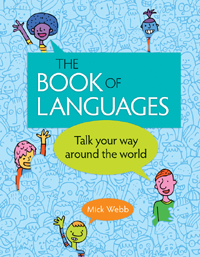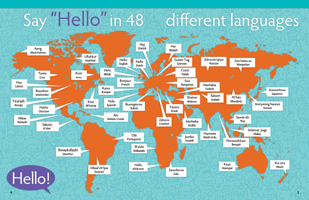| ________________
CM . . .
. Volume XXII Number 6. . . .October 9, 2015

 |
The Book of Languages: Talk Your Way Around the World.
Mick Webb.
Toronto, ON: Owlkids Books, 2015.
64 pp., hardcover, $17.95.
ISBN 978-1-77147-155-8.
Subject Heading:
Language and languages-Juvenile literature.
Grades 4-7 / Ages 9-12.
Review by Gail Hamilton.
*** /4
|
| |
|

excerpt:
Danish has long words that are made of several, shorter, joined-up nouns. For example, Kvindehåndboldland-sholdet means “the female handball national team.”
Danish nouns are divided into two types: common or neuter. The word for “a” is en with common nouns and et with neuter nouns. “A boy, a girl” are en dreng, en pige, but “a house” is et hus, as the word hus is neuter.
To say “the boy”, “the girl” or “the house”, you put en or et on the end of the noun: drengen, pigen, huset.
It is estimated that there are nearly 7,000 languages spoken in the world today, some of them by millions of people and others by just a few. Half of the world’s languages are in danger of dying out altogether. Languages can be spoken, written or nonverbal. Examples of nonverbal languages include sign language, semaphore (flags), drumming, computer codes, braille, whistling and Morse code. Communication is not limited to humans. Some examples from the animal kingdom include the bee dance which bees perform to tell other members of the hive how far and in what direction the source of nectar is, whale songs, dog barking, and the ability of some animals, such as reef squid, to change colour to indicate their interest in mating.
The book begins and ends with a map of the world, the first showing how people say “hello” in 48 different countries, and the second telling how those same people say “goodbye”. It discusses the importance of language, provides a brief history, and explains how language was spread through trade, migration and war; it presents facts, such as the most spoken language (Mandarin Chinese), the discovery of new languages, “textese”, slang, and invented languages from films and literature (for instance, Quenya, one of the Elvish languages which J. R. R. Tolkien created for his Lord of the Rings trilogy).
 Languages can be broken down into 110 separate families, eight of which are described briefly in the book. The majority of the book consists of double-page spreads, each one devoted to one of 21 of the most commonly spoken languages. For ease of reading, the words have been changed to Latin script. Each spread provides a short history of the specific language, a map highlighting the countries in which it is spoken, greetings, the pronunciation of the numbers one to ten, pronunciation points, a brief sample conversation, and a list of countries and their national flags. Along the right hand page is the alphabet written in the featured language with the phonetic pronunciation printed beneath each letter. Though most of the book is easy to comprehend, the “Language Matters” text boxes can be somewhat confusing with their explanations of gender and verb endings, polite versus friendly addresses (in the case of “ty” or “vy” for the word “you” in Russian, similar to “tu” versus “vous” in French) and how letters can have different sounds, depending on where they appear in the word (as is the case in Korean).
Languages can be broken down into 110 separate families, eight of which are described briefly in the book. The majority of the book consists of double-page spreads, each one devoted to one of 21 of the most commonly spoken languages. For ease of reading, the words have been changed to Latin script. Each spread provides a short history of the specific language, a map highlighting the countries in which it is spoken, greetings, the pronunciation of the numbers one to ten, pronunciation points, a brief sample conversation, and a list of countries and their national flags. Along the right hand page is the alphabet written in the featured language with the phonetic pronunciation printed beneath each letter. Though most of the book is easy to comprehend, the “Language Matters” text boxes can be somewhat confusing with their explanations of gender and verb endings, polite versus friendly addresses (in the case of “ty” or “vy” for the word “you” in Russian, similar to “tu” versus “vous” in French) and how letters can have different sounds, depending on where they appear in the word (as is the case in Korean).
Illustrations include maps, charts, diagrams, cartoon-like drawings and a few photographs. A table of contents, a glossary and an index are provided.
Some readers will find it fun to say a few words in another language, but, generally, this book has a limited audience.
Recommended.
Gail Hamilton is a former teacher-librarian in Winnipeg, MB.

To comment
on this title or this review, send mail to cm@umanitoba.ca.
Copyright © the Manitoba Library Association. Reproduction for personal
use is permitted only if this copyright notice is maintained. Any
other reproduction is prohibited without permission.
Next Review | Table of Contents For This Issue - October 9, 2015
CM Home | Back Issues
| Search
| CM Archive
| Profiles Archive
|

 Languages can be broken down into 110 separate families, eight of which are described briefly in the book. The majority of the book consists of double-page spreads, each one devoted to one of 21 of the most commonly spoken languages. For ease of reading, the words have been changed to Latin script. Each spread provides a short history of the specific language, a map highlighting the countries in which it is spoken, greetings, the pronunciation of the numbers one to ten, pronunciation points, a brief sample conversation, and a list of countries and their national flags. Along the right hand page is the alphabet written in the featured language with the phonetic pronunciation printed beneath each letter. Though most of the book is easy to comprehend, the “Language Matters” text boxes can be somewhat confusing with their explanations of gender and verb endings, polite versus friendly addresses (in the case of “ty” or “vy” for the word “you” in Russian, similar to “tu” versus “vous” in French) and how letters can have different sounds, depending on where they appear in the word (as is the case in Korean).
Languages can be broken down into 110 separate families, eight of which are described briefly in the book. The majority of the book consists of double-page spreads, each one devoted to one of 21 of the most commonly spoken languages. For ease of reading, the words have been changed to Latin script. Each spread provides a short history of the specific language, a map highlighting the countries in which it is spoken, greetings, the pronunciation of the numbers one to ten, pronunciation points, a brief sample conversation, and a list of countries and their national flags. Along the right hand page is the alphabet written in the featured language with the phonetic pronunciation printed beneath each letter. Though most of the book is easy to comprehend, the “Language Matters” text boxes can be somewhat confusing with their explanations of gender and verb endings, polite versus friendly addresses (in the case of “ty” or “vy” for the word “you” in Russian, similar to “tu” versus “vous” in French) and how letters can have different sounds, depending on where they appear in the word (as is the case in Korean).